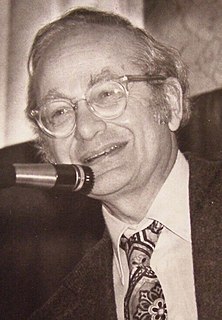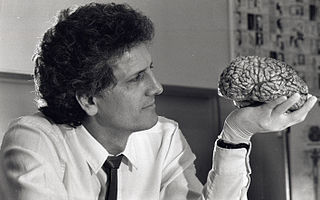Related Research Articles

Neuroscience is the scientific study of the nervous system. It is a multidisciplinary branch of biology that combines physiology, anatomy, molecular biology, developmental biology, cytology, mathematical modeling, and psychology to understand the fundamental and emergent properties of neurons and neural circuits. The understanding of the biological basis of learning, memory, behavior, perception, and consciousness has been described by Eric Kandel as the "ultimate challenge" of the biological sciences.

Patricia Smith Churchland is a Canadian-American analytical philosopher noted for her contributions to neurophilosophy and the philosophy of mind. She is UC President's Professor of Philosophy Emerita at the University of California, San Diego (UCSD), where she has taught since 1984. She has also held an adjunct professorship at the Salk Institute for Biological Studies since 1989. She is a member of the Board of Trustees Moscow Center for Consciousness Studies of Philosophy Department, Moscow State University. In 2015, she was elected a Fellow of the American Academy of Arts & Sciences. Educated at the University of British Columbia, the University of Pittsburgh, and the University of Oxford, she taught philosophy at the University of Manitoba from 1969 to 1984 and is married to the philosopher Paul Churchland. Larissa MacFarquhar, writing for The New Yorker, observed of the philosophical couple that: "Their work is so similar that they are sometimes discussed, in journals and books, as one person."

A neuroscientist is a scientist who has specialised knowledge in the field of neuroscience, the branch of biology that deals with the physiology, biochemistry, anatomy and molecular biology of neurons and neural circuits and especially their association with behaviour and learning.

David Hunter Hubel was a Canadian American neurophysiologist noted for his studies of the structure and function of the visual cortex. He was co-recipient with Torsten Wiesel of the 1981 Nobel Prize in Physiology or Medicine, for their discoveries concerning information processing in the visual system. For much of his career, Hubel was the John Franklin Enders University Professor of Neurobiology at Harvard Medical School. In 1978, Hubel and Wiesel were awarded the Louisa Gross Horwitz Prize from Columbia University.

Paul Greengard was an American neuroscientist best known for his work on the molecular and cellular function of neurons. In 2000, Greengard, Arvid Carlsson and Eric Kandel were awarded the Nobel Prize for Physiology or Medicine for their discoveries concerning signal transduction in the nervous system. He was Vincent Astor Professor at Rockefeller University, and served on the Scientific Advisory Board of the Cure Alzheimer's Fund, as well as the Scientific Council of the Brain & Behavior Research Foundation. He was married to artist Ursula von Rydingsvard.
UCL Neuroscience is a research domain that encompasses the breadth of neuroscience research activity across University College London's (UCL) School of Life and Medical Sciences. The domain was established in January 2008, to coordinate neuroscience activity across the many UCL departments and institutes in which neuroscience research takes place. In 2014, the Nobel Prize in Physiology or Medicine was awarded to the UCL neuroscientist John O'Keefe. In two consecutive years 2017 and 2018, the Brain Prize, the world's most valuable prize for brain research at €1m, was awarded to UCL neuroscientists Peter Dayan, Ray Dolan, John Hardy, and Bart De Strooper.
Thomas Michael Jessell was the Claire Tow Professor of biochemistry and molecular biophysics at Columbia University in New York and a prominent developmental neuroscientist. In 2018, Columbia University announced his termination from his administrative positions after an internal investigation uncovered violations of university policies. He died shortly after from a rapidly neurodegenerative condition diagnosed as progressive supranuclear palsy.
Sten Grillner is a Swedish neurophysiologist and distinguished professor at the Karolinska Institute's Nobel Institute for Neurophysiology in Stockholm where he is the director of the institute. He is considered one of the world’s foremost experts in the cellular bases of motor behaviour. His research is focused on understanding the cellular bases of motor behaviour; in particular, he has shown how neuronal circuits in the spine help control rhythmic movements, such as those needed for locomotion. He is current secretary general of International Brain Research Organization IBRO and President of the Federation of European Neuroscience Societies (FENS). For his work, in 2008 he was awarded the $1 million Kavli Prize for deciphering the basic mechanisms which govern the development and functioning of the networks of cells in the brain and spinal cord. This prize distinguish the recipient from the Nobel prizes in basic medical sciences.
Ricardo Miledi was a Mexican neuroscientist known for his work deciphering the role of calcium in neurotransmitter release.
Richard Lewis Huganir is a Bloomberg Distinguished Professor in the Departments of Neuroscience and Psychological and Brain Sciences, Director of the Solomon H. Snyder Department of Neuroscience, and co-director of the Johns Hopkins Medicine Brain Science Institute at the Johns Hopkins University School of Medicine. He has joint appointments in the Department of Biological Chemistry and the Department of Pharmacology and Molecular Sciences in the Johns Hopkins School of Medicine.
David J. Anderson is an American neurobiologist. He is a Howard Hughes Medical Institute investigator. His lab is located at the California Institute of Technology, where he currently holds the position of Seymour Benzer Professor of Biology, TianQiao and Chrissy Chen Leadership Chair and Director, TianQiao and Chrissy Chen Institute for Neuroscience. Anderson is a founding adviser of the Allen Institute for Brain Research, a non-profit research institute funded by the late Paul G. Allen, and spearheaded the Institute's early effort to generate a comprehensive map of gene expression in the mouse brain.

Edvard Ingjald Moser is a Norwegian professor of psychology and neuroscience at the Kavli Institute for Systems Neuroscience, at the Norwegian University of Science and Technology (NTNU) in Trondheim. In 2005 he discovered grid cells in the brain's medial entorhinal cortex. Grid cells are specialized neurons that provide the brain with a coordinate system and a metric for space. In 2018 he discovered a neural network that expresses your sense of time in experiences and memories located in the brain's lateral entorhinal cortex He shared the Nobel Prize in Physiology or Medicine in 2014 with long-term collaborator May-Britt Moser and previous mentor John O'Keefe for their work identifying the brain's positioning system. The two main components of the brain's GPS are; grid cells and place cells, a specialized type of neuron that respond to specific locations in space. Together with May-Britt Moser he established the Moser research environment, which they lead.

May-Britt Moser is a Norwegian psychologist and neuroscientist, who is a Professor of Psychology and Neuroscience at the Norwegian University of Science and Technology (NTNU). She and her then-husband, Edvard Moser, shared half of the 2014 Nobel Prize in Physiology or Medicine, awarded for work concerning the grid cells in the entorhinal cortex, as well as several additional space-representing cell types in the same circuit that make up the positioning system in the brain. Together with Edvard Moser she established the Moser research environment at NTNU, which they lead. Since 2012 she heads the Centre for Neural Computation.
Ingrid Suzanne Johnsrude is a Canadian neuroscientist, a professor of psychology at University of Western Ontario, and was the holder of the Canada Research Chair in Cognitive Neuroscience. Her research involves brain imaging, the connections between brain structure and language ability, and the diagnosis of degenerative brain diseases in the elderly.
Graham Leon Collingridge is a British neuroscientist and professor at the University of Toronto and at the University of Bristol. He is also a senior investigator at the Lunenfeld-Tanenbaum Research Institute, Mount Sinai Hospital in Toronto.

John O'Keefe, is an American-British neuroscientist and a professor at the Sainsbury Wellcome Centre for Neural Circuits and Behaviour and the Research Department of Cell and Developmental Biology at University College London. He discovered place cells in the hippocampus, and that they show a specific kind of temporal coding in the form of theta phase precession. He shared the Nobel Prize in Physiology or Medicine in 2014, together with May-Britt Moser and Edvard Moser; he has received several other awards. He has worked at the University College London for his entire career, but also held a part-time chair at the Norwegian University of Science and Technology at the behest of his Norwegian collaborators, the Mosers.

George Paxinos AO FASSA FAA is a Greek Australian neuroscientist, born in Ithaca, Greece. He completed his BA in psychology at the University of California at Berkeley and his PhD at McGill University in Montreal, Canada. After a postdoctoral year at Yale University, he moved to the School of Psychology of the University of New South Wales in Sydney, Australia. He is currently an NHMRC Senior Principal Research Fellow at Neuroscience Research Australia and Scientia Professor of Psychology and Medical Sciences at the University of New South Wales.
The Perl-UNC Prize is awarded internationally in the field of neuroscience. Its purpose is two-fold: to recognize researchers for outstanding discoveries and seminal insights in neuroscience and to celebrate the strength of the neuroscience research program at the University of North Carolina at Chapel Hill. As of 2017, six recipients of the Perl-UNC Prize have gone on to win Nobel Prizes; an additional three have won Kavli Prizes in Neuroscience.

Alan Charles Evans FRSC FCAHS is a Welsh-born Canadian neuroscientist who is a James McGill Professor of Neurology and Neurosurgery, Psychiatry and Biomedical Engineering at McGill University. He is also a researcher at the McConnell Brain Imaging Centre of the Montreal Neurological Institute, Co-Director of the Ludmer Centre for Neuroinformatics and Mental Health, Director of the McGill Centre for Integrative Neuroscience, Scientific Director of the Canadian Open Neuroscience Platform, Scientific Director of McGill's Healthy Brains for Healthy Lives program and Principal Investigator of CBRAIN, an initiative aiming to integrate Canadian neuroscience data with the Compute Canada computing network. He is recognized for his research on brain mapping, and was a co-founder of both the International Consortium for Brain Mapping and the Organization for Human Brain Mapping. In 2014, he was awarded the Prix d’innovation et d’excellence Dr Jean-A.-Vézina for Québec radiology and the University of British Columbia's Margolese National Brain Disorders Prize. In the same year, he was recognized as an ISI Highly Cited Researcher in the category "Neuroscience and Behavior", a ranking he has maintained every year since then. He was elected a Fellow of the Royal Society of Canada in 2015. In 2016, he received the Wilder Penfield Prix du Québec and was ranked #6 in a list of 10 most influential neuroscientists of the modern era by Science magazine. In 2017, he was inducted as a Fellow of the Canadian Academy of Health Sciences and awarded the Senate of Canada 150 Medal. In 2018, he was awarded the Heinz Lehmann Prize for Outstanding Contributions to Neuropsychopharmacology and the Club de Recherches Cliniques du Québec Mentorship Award. In 2019, he received the Glass Brain Award from the Organization for Human Brain Mapping for lifetime achievement in neuroimaging.
References
- ↑ "The Nobel Prize in Physiology or Medicine 2014". NobelPrize.org. Retrieved 25 February 2019.
- 1 2 "Bruce McNaughton". University of California, Irvine. Retrieved 24 February 2019.
- ↑ "Dr. Bruce McNaughton". University of Lethbridge. Retrieved 24 February 2019.
- ↑ Cruz, Sherri (3 March 2014). "UCI boosts its brain power with top neuroscientist". Orange County Register. Retrieved 24 February 2019.
- ↑ "Three U of L professors elected to the Fellowship of the Royal Society of Canada". UNews. 7 September 2016. Retrieved 24 February 2019.